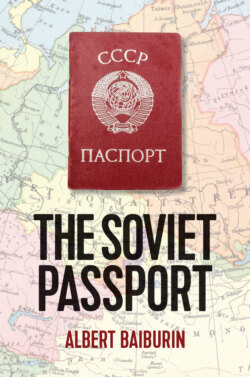The Soviet Passport

Реклама. ООО «ЛитРес», ИНН: 7719571260.
Оглавление
Albert Baiburin. The Soviet Passport
CONTENTS
Guide
List of Illustrations
List of Plates
Pages
New Russian Thought
The Soviet Passport. The History, Nature and Uses of the Internal Passport in the USSR
Abbreviations
Foreword ‘Remove the document – and you remove the man’
Notes
Preface
Introduction
1
2
3
4
5
6
7
8
9
Notes
1 The Formation of ‘the Passport Portrait’ in Russia
Notes
2 Fifteen Passport-less Years
Notes
3 The Introduction of the Passport System in the USSR (1932–1936) General Situation
The Official Version of the Introduction of Passports
Organizational Work
Issuing Passports
‘Legal Excesses’
The Second Phase of the Introduction of Passports
The Consequences of the Introduction of Passports
Notes
4 Passport Regimes and Passport Reforms. Passport Regimes
The Hundred-and-First Kilometre
ThePropiska
Registering ‘Natural Population Changes’
Maintaining the Passport Regime
Statutes on Passports and Instructions for Passport Work in 1940 and 1953
Reform Projects of the 1960s
The 1974 Statute
From the Soviet to the Russian Passport System
Notes
5 The Passport Template and the Individual’s Basic Information
The Passport Template
‘Surname, Name, Patronymic’
‘Place and Date of Birth’
‘Ethnic Origin’
‘The Personal Signature’
‘Social Status’
‘Liability for Military Service’
Notes
6 The Observations and Properties of the Passport ‘Who Issued the Passport’
‘On the Basis of Which Documents is the Passport Issued’
‘People Listed in the Holder’s Passport’
The Photograph
Special Observations
The Observation about Being Taken On for and Released from Work
The Observation about Marriage and Divorce
The Observation about Alimony Payments
Observations about Restrictions on the Place of Residence
Observations about thePropiska
Notes
7 Receiving a Passport. The Right to a Passport
Defining Ethnicity
Taking the Passport Photograph
How Do I Sign?
The Passport Desk and thePasportistka
Receiving the Passport
Notes
8 Life With – and Without – the Passport. Look After It; Should You Carry It With You?
The Document Check
Changing One’s Name
The Traditional Background
The Official Regulatory Procedure for Changing Names
The Practical Side of Changing Your First Name
A ‘Clean’ Passport
Marriages of Convenience
Lost! What it Meant to be Without Your Passport
Refusing to Have a Passport
‘The Most Important Document’ and Why it was Needed
Notes
Conclusion
Note
Appendix. Interview Details
The Type of Questions Asked in the Interviews. First Impressions of the Passport
Receiving Your Passport
The Contents of the Passport
What You Thought of Your Passport and Situations Where It Was Needed
Marrying; and Ending a Marriage
Exchanging Your Passport
Errors in the Passport and Violations of the Rules
Passport for Foreign Travel; and Passports of Other Countries
Glossary
Bibliography
Sources in the English (or French or German) Language
Index. A
B
C
D
E
F
G
H
I
K
L
M
N
O
P
R
S
T
U
V
W
Y
Z
POLITY END USER LICENSE AGREEMENT
Отрывок из книги
The publication of this series was made possible with the support of the Zimin Foundation
Albert Baiburin, The Soviet Passport
.....
The type of check carried out – the actual act of certifying a person’s identity – also depends on the particular situation. In an official institution, a pass should be shown even when the person checking passes knows the bearer well. It is assumed that there is a purpose to the identification process, which is just as important as knowing who the person is. On entering a public library, it is sufficient to flash your reader’s ticket without even opening it; and a full-time member of staff of an institute may not even have to show any identification. They may have to show their pass only if there is a check in progress. Naturally, it helps if you have good relations with the person checking passes (if there is one); how you show your pass; the condition it is in, and so on. But none of this has anything to do with the contents of the document. From this (purely pragmatic) point of view, the document ‘works’ depending on the context. Sometimes you have to show it clearly, on other occasions it all depends on your personal status.
An important element in researching documents is the question of trust. This became a subject of study at the start of the twentieth century.24 A new twist in this study is the need to define the understanding of the term and where it exists (as has been described by Piotr Sztompka, Geoffrey Hosking and others).25 Its role in particular circumstances needs to be clarified, including cases with documents, which can probably be considered as instruments ‘for formalizing the practice of trust’ (in the words of Irina Kaspe). However, this does not always happen, at least in Soviet practice.
.....